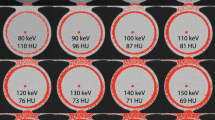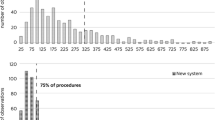Abstract
Objectives The aim of this study was to quantify the radiation dose reduction during coronary angiography and percutaneous coronary intervention (PCI) through removal of the anti-scatter grid (ASG), and to assess its impact on image quality in adult patients with a low body mass index (BMI). Methods A phantom with different thicknesses of acrylic was used with a Westmead Test Object to simulate patient sizes and assess image quality. 129 low BMI patients underwent coronary angiography or PCI with or without the ASG in situ. Radiation dose was compared between both patient groups. Results With the same imaging system and a comparable patient population, ASG removal was associated with a 47% reduction in total dose-area product (DAP) (p < 0.001). Peak skin dose was reduced by 54% (p < 0.001). Operator scatter was reduced to a similar degree and was significantly reduced through removal of the ASG. Using an image quality phantom it was demonstrated that image quality remained satisfactory. Conclusions Removal of the ASG is a simple and effective method to significantly reduce radiation dose in coronary angiography and PCI. This was achieved while maintaining adequate diagnostic image quality. Selective removal of the ASG is likely to improve the radiation safety of cardiac angiography and interventions.





Similar content being viewed by others
References
ICRP. The recommendations of the International Commission on Radiological Protection (2007) ICRP Publication 103. Ann ICRP 37:1-332
Eastman TR (2013) ALARA and digital imaging systems. Radiol Technol 84:297–298
Agarwal S, Parashar A, Ellis SG, Heupler FA Jr, Lau E, Tuzcu EM, Kapadia SR (2014) Measures to reduce radiation in a modern cardiac catheterization laboratory. Circ Cardiovasc Interv 7:447–455
Chambers CE, Fetterly KA, Holzer R, Lin PJ, Blankenship JC, Balter S, Laskey WK (2011) Radiation safety program for the cardiac catheterization laboratory. Catheter Cardiovasc Interv 77:546–556
Gilligan P, Lynch J, Eder H, Maguire S, Fox E, Doyle B, Casserly I, McCann H, Foley D (2015) Assessment of clinical occupational dose reduction effect of a new interventional cardiology shield for radial access combined with a scatter-reducing drape. Catheter Cardiovasc Interv 86:935–940
Christopoulos G, Papayannis AC, Alomar M, Kotsia A, Michael TT, Rangan BV, Roesle M, Shorrock D, Makke L, Layne R, Grabarkewitz R, Haagen D, Maragkoudakis S, Mohammad A, Saroude K, Cipher DJ, Chambers CE, Banerjee S, Brilakis ES (2014) Effect of a real-time radiation monitoring device on operator radiation exposure during cardiac catheterization: the radiation reduction during cardiac catheterization using real-time monitoring study. Circ Cardiovasc Interv 7:744–750
Alazzoni A, Gordon CL, Syed J, Natarajan MK, Rokoss M, Schwalm JD, Mehta SR, Sheth T, Valettas N, Velianou J, Pandie S, Al Khdair D, Tsang M, Meeks B, Colbran K, Waller E, Fu Lee S, Marsden T, Jolly SS (2015) Randomized Controlled Trial of Radiation Protection With a Patient Lead Shield and a Novel, Nonlead Surgical Cap for Operators Performing Coronary Angiography or Intervention. Circ Cardiovasc Interv 8:e 002384
Smith IR, Stafford WJ, Hayes JR, Adsett MC, Dauber KM, Rivers JT (2016) Radiation risk reduction in cardiac electrophysiology through use of a gridless imaging technique. Europace 18:121–130
Ricciardello M, McLean D (1995) Assessment of fluoroscopic systems with a simple test object. Australas Phys Eng Sci Med 18:104–113
Wilson SM, Prasan AM, Virdi A, Lassere M, Ison G, Ramsay DR, Weaver JC (2016) Real-time colour pictorial radiation monitoring during coronary angiography: effect on patient peak skin and total dose during coronary angiography. Eurointervention 12:e939–e947
Stecker MS, Balter S, Towbin RB, Miller DL, Vañó E, Bartal G, Angle JF, Chao CP, Cohen AM, Dixon RG, Gross K, Hartnell GG, Schueler B, Statler JD, de Baère T, Cardella JF (2009) Guidelines for patient radiation dose management. J Vasc Interv Radiol 20:S263–S273
Compliance requirements for ionizing radiation apparatus used in diagnostic imaging. Australian Environment protection authority; Radiation Guideline 6 available at http://www.epa.nsw.gov.au
Ciraj-Bjelac O, Rehani M, Minamoto A, Sim KH, Liew HB, Vano E (2012) Radiation-induced eye lens changes and risk for cataract in interventional cardiology. Cardiology 123:168–171
Suzuki S, Furui S, Kohtake H, Yokoyama N, Kozuma K, Yamamoto Y, Isshiki T (2006) Radiation exposure to patient’s skin during percutaneous coronary intervention for various lesions, including chronic total occlusion. Circ J 70:44–48
Roguin A, Goldstein J, Bar O, Goldstein JA (2013) Brain and neck tumors among physicians performing interventional procedures. Am J Cardiol 111:1368–1372
Ubeda C, Vano E, Gonzalez L, Miranda P (2013) Influence of the antiscatter grid on dose and image quality in pediatric intervention al cardiology X-ray systems. Catheter Cardiovasc Interv 82:51–57
Partridge J, McGahan G, Causton S, Bowers M, Mason M, Dalby M, Mitchell A (2006) Radiation dose reduction without compromise of image quality in cardiac angiography and intervention with the use of a flat panel detector without an antiscatter grid. Heart 92:507–510
IEC. International Electrotechnical Commission IEC 60601-2-43 ed 2.0 (2010) Medical electrical equipment - Part 2–43: Particular requirements for the basic safety and essential performance of X-ray equipment for interventional procedures. Geneva, Switzerland
Fetterly K, Schuler B (2007) Experimental evaluation of fiber-interspaced anti-scatter grids for large patient imaging with digital X-ray systems. Phys Med Biol 52:4863–4880
Author information
Authors and Affiliations
Corresponding author
Ethics declarations
Conflict of interest
GI has accepted travel support from Toshiba Medical Systems to attend conferences.
Rights and permissions
About this article
Cite this article
Roy, J.R., Sun, P., Ison, G. et al. Selective anti-scatter grid removal during coronary angiography and PCI: a simple and safe technique for radiation reduction. Int J Cardiovasc Imaging 33, 771–778 (2017). https://doi.org/10.1007/s10554-017-1067-5
Received:
Accepted:
Published:
Issue Date:
DOI: https://doi.org/10.1007/s10554-017-1067-5




